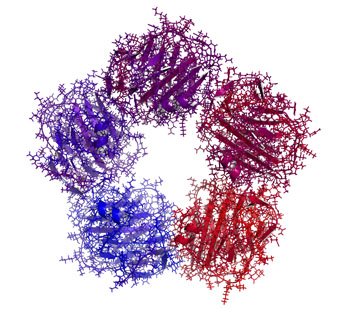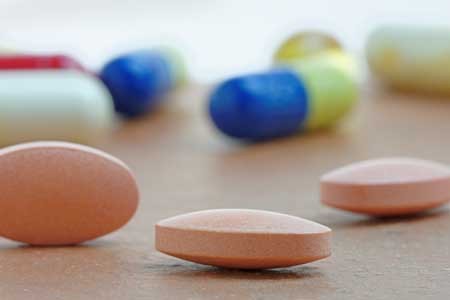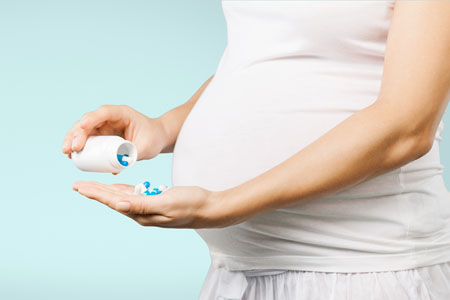Dextromethorphan potentiates the anti-depressant effects of SSRIs
Maji et al reported in Psychiatry Research (2024) that dextromethorphan 30mg compared to placebo potentiated the antidepressant effects of SSRIs on all measures and had few side effects. It is FDA-approved to potentiate bupropion.
Now it looks like a more general property.
Vortioxetine Improves Cognition, Major Depression in Early Dementia
Vortioxetine (5mg then 10mg) significantly improves depressive symptoms, cognitive performance, functioning, and quality of life at 12 weeks in patients with both major depressive disorder (MDD) and early-stage dementia. In addition to blocking 5HT (serotonin) reuptake vortioxetine antagonizes 5 serotonin receptors with 5HT3 and 5HT7 likely accounting for the positive effects on processing speed and cognitive functioning.
Potential Problems when Youth at Risk for Bipolar Disorder Take SSRIs
 At a symposium at the 2019 meeting of the American Academy of Child and Adolescent Psychiatry, researcher Manpreet Singh reported that in youth at high risk for bipolar disorder, 53% had an adverse event while taking a selective serotonin reuptake inhibitor antidepressant (SSRI), and 26% had a new onset of suicidality while taking an SSRI. These adverse events were associated with reduced size and increased activation of the amygdala, the brain region responsible for emotion processing. Singh concluded that dysfunction in the prefrontal-limbic network may predict adverse events in children at risk for bipolar disorder when they are given SSRI antidepressants. She urged caution in the use of antidepressants in this population. Researcher Joseph Biederman echoed this caution later in the meeting.
At a symposium at the 2019 meeting of the American Academy of Child and Adolescent Psychiatry, researcher Manpreet Singh reported that in youth at high risk for bipolar disorder, 53% had an adverse event while taking a selective serotonin reuptake inhibitor antidepressant (SSRI), and 26% had a new onset of suicidality while taking an SSRI. These adverse events were associated with reduced size and increased activation of the amygdala, the brain region responsible for emotion processing. Singh concluded that dysfunction in the prefrontal-limbic network may predict adverse events in children at risk for bipolar disorder when they are given SSRI antidepressants. She urged caution in the use of antidepressants in this population. Researcher Joseph Biederman echoed this caution later in the meeting.
Baseline Levels of CRP Could Help Predict Clinical Response to Different Treatments
C-reactive protein, or CRP, is a marker or inflammation that has been linked to depression and other illnesses. People with high levels of CRP respond differently to medications than people with lower CRP, so assessing CRP levels may help determine which medications are best to treat a given patient.
High baseline levels of CRP (3–5pg/ml) predict a poor response to selective serotonin reuptake inhibitor antidepressants (SSRIs) and to psychotherapy, and are associated with increased risk of recurrent depression, heart attack, and stroke.
However, high baseline CRP predicts a better response to the antidepressants nortriptyline and bupropion. High CRP is also associated with better antidepressant response to infliximab (a monoclonal antibody that inhibits the inflammatory cytokine TNF alpha), while low levels of CRP predict worsening depression upon taking infliximab.
High baseline CRP also predicts good antidepressant response to intravenous ketamine (which works rapidly to improve treatment-resistant depression), minocycline (an anti-inflammatory antibiotic that decreases microglial activation), L-methylfolate (a supplement that can treat folate deficiency), N-acetylcysteine (an antioxidant that can improve depression, pathological habits, and addictions), and omega-3 fatty acids (except in people with low levels of DHA).
High baseline CRP also predicts a good response to the antipsychotic drug lurasidone (marketed under the trade name Latuda) in bipolar depression. In people with high baseline CRP, lurasidone’s positive results have a huge effect size of 0.85, while in people with low CRP (<3pg/ml) the improvement on lurasidone has a smaller effect size (0.35).
In personal communications with this editor (Robert M. Post) in 2018, experts in the field (Charles L. Raison and Vladimir Maletic) agreed that assessing baseline CRP levels in a given patient could help determine optimal strategies to treat their depression and predict the patient’s responsiveness to different treatment approaches.
At a 2018 scientific meeting, researchers Cynthia Shannon, Thomas Weickert, and colleagues reported that high baseline levels of CRP were associated with symptom improvement in patients with schizophrenia when they were treated with the drug canakinumab (marketed under the trade name Ilaris). Canakinumab is a human monoclonal antibody that targets the inflammatory cytokine interleukin-1 beta (Il-1b). Il-1b is elevated in a subgroup of patients with depression, bipolar disorder, or schizophrenia, and CRP levels are an indication of the associated inflammation.
Combination of SSRIs and Statins Better than SSRIs Alone
A large study in Denmark suggests that taking selective serotonin reuptake inhibitor (SSRI) antidepressants alongside cholesterol-lowering statin drugs improved depression more than SSRIs alone. The findings, by Ole Köhler and colleagues were reported in the American Journal of Psychiatry in 2016.
The study included 872,216 people in Denmark’s national health care database who took SSRIs between 1997 and 2012. The most common SSRIs were citalopram, sertraline, and escitalopram. Of these people taking SSRIs, 13.0% also took a statin drug, typically simvastatin. Those patients who were taking both an SSRI and a statin were less likely than those taking an SSRI alone to be hospitalized for any psychiatric problem, or for depression specifically.
Depression is known to be correlated with inflammation throughout the body. Statins reduce this inflammation as well as lowering cholesterol. A 2013 study by Ahmad Ghanizadeh and Arvin Hedayati in the journal Depression and Anxiety showed that the SSRI fluoxetine and the statin lovastatin reduced depression severity compared to fluoxetine alone.
The combination of SSRIs and statins did not seem to reduce deaths or suicidal behavior compared to SSRIs alone. Statins have some side effects, but combining them with antidepressants did not increase the risks associated with their use.
SSRI Use During Pregnancy Linked to Adolescent Depression in Offspring
A 2016 article by Heli Malm and colleagues in the Journal of the American Academy of Child and Adolescent Psychiatry suggests that in utero exposure to selective serotonin reuptake inhibitor (SSRI) antidepressants may increase the risk of depression in adolescence. However, the study included potentially confounding factors. It is possible that women who took SSRIs during pregnancy had more severe depression than those who went unmedicated during pregnancy. The mothers in the study who took SSRIs also had more comorbid conditions such as substance abuse.
Editor’s Note: Women should balance the risks and benefits of antidepressant use during pregnancy, since depression itself can have adverse effects on both mother and fetus. It has recently been established that SSRI use during pregnancy does not cause birth defects, so women with depression that has not responded to non-pharmaceutical interventions such as psychotherapy, omega-3 fatty acid supplementation, exercise, mindfulness, and repeated transcranial magnetic stimulation (rTMS) may still want to consider SSRIs.
Most SSRIs Free of Birth Defect Risk Early in Pregnancy, Fluoxetine and Paroxetine are Exceptions
A large study of women who took selective serotonin reuptake inhibitor (SSRI) antidepressants in the month before pregnancy and throughout the first trimester suggests that there is a smaller risk of birth defects associated with SSRI use than previously thought, though some risks were elevated in women who took paroxetine or fluoxetine.
The 2015 study, by Jennita Reefhuis and colleagues in the journal BMJ, investigated the drugs citalopram, escitalopram, fluoxetine, paroxetine, and sertraline, and examined birth defects that had previously been associated with SSRI use in smaller studies. The participants were 17,952 mothers of infants with birth defects and 9,857 mothers of infants without birth defects who had delivered between 1997 and 2009.
Sertraline was the most commonly used SSRI among the women in the study. None of the birth defects included in the study were associated with sertraline use early in pregnancy. The study found that some birth defects were 2 to 3.5 times more likely to occur in women who had taken fluoxetine or paroxetine early in their pregnancies.
Five different birth defects, while uncommon, were statistically linked to paroxetine use: anencephaly (undersized brain), heart problems including atrial septal defects and right ventricular outflow tract obstruction defects, and defects in the abdominal wall including gastroschisis and omphalocele. Two types of birth defects were associated with fluoxetine use: right ventricular outflow tract obstruction defects and craniosynostosis (premature fusion of the skull bones). Absolute incidence of these defects was also low.
Transcranial Direct Current Stimulation Reduces Depression Following Strokes
One-third of people who have strokes face depression afterward. New research is looking to expand the safe options for the treatment of depression following strokes. At the 2015 meeting of the Society of Biological Psychiatry, researchers led by Leandro Valiengo presented their successful randomized, sham-controlled double-blind study of transcranial direct current stimulation for post-stroke depression. Forty-eight people who had depression following a stroke were randomized to receive either a sham procedure or tDCS in twelve 30-minute sessions over a period of six weeks. After the six weeks, those who received tDCS had fewer symptoms of depression, more remission, and better response. There were no serious side effects.
TDCS is very low-level electrical current that has a positive (anode) or negative (cathode) electrode. Anodal stimulation of the cortex is usually associated with positive effects on mood and cognition. TDCS sessions in this study consisted of 2-mA anodal left/cathodal right dorsolateral prefrontal stimulation.
Editor’s Note: Placebo-controlled studies have repeatedly indicated that patients who have a stroke show better neurological and psychiatric response afterward when they are given an selective serotonin reuptake inhibitor (SSRI) antidepressant, whether or not they have depression or a prior history of depression. If a neurologist does not suggest treatment with an SSRI after a stroke, ask why not. Since antidepressants increase brain levels of brain-derived neurotrophic factor (BDNF) and increase neurogenesis, they could help with post-stroke recovery.
Study Finds No Substantial Risk of Infant Cardiac Problems from Antidepressant Use During Pregnancy
In the past there has been some concern that selective serotonin reuptake inhibitor (SSRI) antidepressants taken during pregnancy could increase an infant’s risk of cardiac problems. There was particular concern that the SSRI paroxetine could lead to right ventricular outflow tract obstruction, and sertraline could lead to ventricular septal defects. A 2014 study by KF Huybrechts et al. in the New England Journal of Medicine analyzed data from 949,504 women in a Medicaid system from three months before pregnancy until one month after delivery during the years 2000-2007.
Infants born to mothers who had taken antidepressants during their first trimester were compared to infants whose mothers had not taken antidepressants. In total, 6.8% or 64,389 women had used antidepressants in their first trimester.
While the rate of cardiac defects in newborns was greater among those mothers who had taken antidepressants (90.1 infants per 10,000 infants who had been exposed to antidepressants versus 72.3 infants per 10,000 infants who had not been exposed to antidepressants), this relationship diminished as confounding variables were removed. The relative risk of any cardiac defect after taking SSRIs was 1.25, but this decreased to 1.12 when restricted to only those mothers who were diagnosed with depression, and to 1.06 when the researchers controlled for things like depression severity. (All relative risk numbers were calculated with a 95% confidence interval.)
The researchers concluded that there is no substantial risk of increased cardiac defects in children born to mothers who took antidepressants during their first trimester.
Exercise Helps Residual Depression
Many patients with depression require two or more treatments in order to achieve remission. In a 2011 study by Trivedi et al. published in the Journal of Clinical Psychiatry, patients with major depressive disorder who had not responded adequately to selective serotonin reuptake inhibitor (SSRI) antidepressants improved when an exercise regimen was added to their regular treatment.
The patients, aged 18-70 years old, were all sedentary at the start of the trial. They were randomized to one of two exercise regimens: a high dose regimen (16 kcal/kg per week, equivalent to walking at about 4 mph for 210 minutes per week) or the low dose (4 kcal/kg per week, equivalent to walking at 3 mph for about 75 minutes per week). Both groups improved significantly by the end of the study. Remission rates (adjusted for differences between groups) were 28.3% for the high dose group and 15.5% for the low dose group.
The rates of improvement with exercise were similar or better to those commonly seen with other augmenting agents such as lithium, T3, buspirone, and atypical antipsychotics, but without side effects and other inconveniences such as blood monitoring.
Other studies have indicated that exercise by itself and in combination with other treatments has efficacy in depression. Exercise can change serotonin and norepinephrine function and can increase brain-derived neurotrophic factor (BDNF), a, and neurogenesis in the hippocampus.
The researchers looked for moderating variables that may have affected the outcomes of various participants. Men, regardless of family history of mental illness, had better remission rates in the high dose group. Women without a family history of mental illness also improved more in the high dose group, while women with a family history of mental illness improved more in the low dose group, though this finding was statistically nonsignificant.
While the researchers observed that those in the high-dose group did exercise more than those in the low-dose group, participants in the high-dose group had more difficulty sticking to their exercise regimen. It may be that even though high doses of exercise offer slightly higher rates of remission, lower doses may be more effective clinically if patients can stick to the low-dose regimen better.








